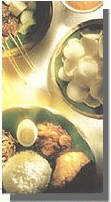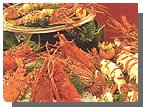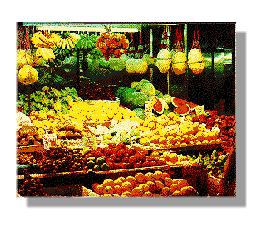![]() Johor
Johor
![]() Malacca
Malacca
![]() Negeri Sembilan
Negeri Sembilan
![]() Selangor
Selangor
![]() Perak
Perak
![]() Kedah
Kedah
![]() Perlis
Perlis
![]() Pahang
Pahang
![]() Terengganu
Terengganu
![]() Kelantan
Kelantan
![]() Penang
Penang
![]() Sabah
Sabah
![]() Sarawak
Sarawak
![]() Kuala Lumpur
Kuala Lumpur
![]() Labuan
Labuan
![]() Putrajaya
Putrajaya

Approximately 112km south of Langkawi, lies the island of PENANG the 'Pearl of the Orient'. When first discovered by Captain Francis Light in 1786, the island was filled with lush tropical vegetation. The betel nut palm was a common sight all over the island - a fact which gave rise to the name of Pulau Pinang (Island of the Betel Nut). Penang has come a long way from its early beginnings as the first British trading post in the Far East. Its capital Georgetown is a bustling metropolitan city with a unique blend of East and West.
By contrast, the famous beaches of Penang - Tanjung Bungah, Batu Ferringhi and Teluk Bahang offer all the scenic delights of tropical island paradise - stretches of golden sandy beaches, clear blue seas and tiny secluded coves enclosed by clusters of rocks. Penang is a resort island in full bloom with numerous hotels of international standard fronting the sea along the beaches on its northern coastlines. The range of facilities and amenities available here makes it an ideal playground for worshippers of the sun and the sea.
But there is another side of Penang that still remains to be discovered. Along the northwestern coastline are some of the fine beaches on the island. Imagine a sparkling sea, powdery white sand, sunlight filtering through coconut groves - the scene of perfect tranquillity. These beaches remain as Penang's best kept secrets because they are relatively inaccessible except by hiking through jungle trails. The rewards would make the effort really worthwhile.
Georgetown, at the north-eastern tip of the island is the seat of administration and is also the commercial hub of the state. This bustling metropolitan city combines the best of east and west as seen in its fascinating collection of fine old buildings, each bearing the stamp of different foreign influences in its colorful history. Much of its charm also lies in its famous golden beaches and clear blue seas. Penang today is a resort island in full bloom - an idyllic playground for worshippers of the sun and the sea. Its multi-racial population contributes to a wealth of cultural attractions and festivals for visitors to bring home memories of happy times in Penang.
Penang today bears the mark of an early history of successive foreign influences - from the early Indian Civilization that took root in northern Malaya to that of the Portuguese, Dutch and later the British who came to this part of the world in search of spices and stayed to participate in the lucrative trade.
The history of modern Penang can be traced back to 1786 when Francis Light managed to persuade the Sultan of Kedah to cede "Pulau Pinang" (island of the Betel nut) to the British East India Company. Light landed at the site of the present Esplanade and according to local legend, fired gold coins into the surrounding jungle to induce his men to clear the area. The island was originally named Prince of Wales Island and the settlement that soon grew up was named Georgetown after King George III. In 1800, the Sultan of Kedah further ceded a strip of land on the mainland across the channel which Light named Province Wellesley, after the then Governor of India. In 1832, Penang formed part of the Straits Settlement with Malacca and Singapore. It flourished and grew to be a major trading post for a lucrative trade in tea, spices, china and cloth. For more than a hundred years, it remained under British Colonial rule until 1957 when it gained independence and became one of the states of the newly formed Federation of Malaya and later Malaysia in 1963.
Botanical Gardens
Butterfly Farm
City Hall Esplanade
Clock Tower
Dharmikarama Burmese Temple
Fort Cornwallis
Kapitan Kling Mosque
Kek Lok Si Temple
Khoo Kongsi
Komtar
Kuan Yin Temple
Penang Bridge
Penang Museum
P. Ramlee's House
Snake Temple
Sri Mariamman Temple
St George's Church
Wat Chayamangkalaram
Forestry Museum
Penang Hill
Penang's Famed Beaches
Penang culture is an eclectic mix of Chinese, Indian, Malay and Western.
Reflexology, the art of promoting good health through the massaging of pressure points on the feet, is part of the Chinese inheritance.
A few generations ago, a unique and distinct culture blossomed in Singapore and the other Straits Settlements of Malacca and Penang. Its people were called the Babas, but they are also known as Peranakans ~ meaning "local-borns." Theirs was a community not only of wealth and influence, but also one rich in tradition and proud of its heritage.
A Baba is a member of a distinct Chinese-Malay subculture which developed over many generations in Malaya, flourished for about one-hundred years from the early-19th to early-20th centuries, and is now almost just a memory on the eve of the 21st. The term Baba also refers to the male members of that group, and the term Nonya refers to its female members.
The term Peranakan is a Malay adjective meaning "local-born." At one time, when combined with a subject, such as in Peranakan Cina, meaning local-born Chinese, it was used to describe people of various non-Malay ethnic groups who had been born and raised in Malaya. However, in modern Singapore, the term Peranakan alone has come to be used interchangeably with the term Baba. Lastly, the term Straits Chinese can refer to any person of Chinese ethnicity born and raised on the Malay Peninsula. Since the Babas are of primarily Chinese ancestry, they can be correctly called Straits Chinese, but a person who is a Straits Chinese is not necessarily a Baba, since the term can also refer to those of pure Chinese ancestry, not the Chinese-Malay mixture that makes a Baba. "A rose by any other name..."
The island of Penang is truly for the gourmet, with a taste sensation for every connoisseur. Here, the adventurous eater can sample the distinctly different cuisine of Malays, Chinese and Indians.
It will truly be a gastronomic crime if one did not sample the local fare while in Penang. Hawkers (open air stalls) are in abundance everywhere, and offer a great variety of food that one could stay for two weeks and still not be able to savour every dish available.
NASI LEMAK A Malay fare of rice cooked in coconut milk, with an assortment of curries and sambals (chilli dishes).
SATAY Sticks of barbecued chicken, mutton or beef pieces served with spicy peanut sauce and slices of cucumber and onions.
LAKSA A Penang specialty, that consists of noodles in a spicy sour soup. The dish is garnished with cucumber, lettuce, pineapple and onions.
CHAR KOAY TEOW A perennial favourite with locals and tourists alike. Flat white noodles are fried together with shrimps, bean sprouts and clams.
LOK LOK A Chinese fondue. Skewers of meat and seafood which cooks in boiling water at the table, and eaten with a rich peanut sauce.
CURRY MEE Blanched noodles (mee) served in a curry soup topped with clams, shrimps, bean sprouts and dried bean cake.

POPIAH Spring rolls consisting of sliced turnip, bean sprouts, prawn paste and chilli sauce.
GADO GADO Malaysian salad of boiled vegetables, served with sauce made from roasted peanuts, coconut milk, shrimp paste, chillies and spices.
CURRY KAPITAN A Nonya dish of chicken cooked with onions, chillies, ginger, coconut oil, sugar and lemon juice. Served with steamed rice.
HOKKIEN MEE Noodles served in a prawn soup, with bean
sprouts, prawns and pork ribs.
NASI KANDAR Served by Indian Muslims, consists of rice with a variety of curries.
KERABU A Nonya salad dish of chopped prawns, chicken, onions, ginger flowers, spices and vinegar.
CHICKEN RICE Another great favourite, it consists of rice cooked in chicken stock and served with pieces of tender chicken either boiled or roasted.
MURTABAK An Indian Muslim style pizza, filled with minced meat, eggs, and onions, fried over a hot plate and served with a curry gravy.
DIM SUM Chinese tit-bits popular at any time of the day, especially for breakfast. It consists of bite-sized dumplings of meat, seafood and vegetables.
YONG TAU FOO Stuffed bean curd, vegetables, fish balls
and other foods served in soup, with a sweet sauce.
 A great variety
of the freshest seafood is available in Penang, with a choice of
fish, lobster, crab, squid or prawns prepared practically in
every known way, from creamy continental to spice local and sweet
sour Chinese styles.
A great variety
of the freshest seafood is available in Penang, with a choice of
fish, lobster, crab, squid or prawns prepared practically in
every known way, from creamy continental to spice local and sweet
sour Chinese styles.
 FRUITS
in Penang are available throughout the year, and the varieties
are endless. Apart from the perennial pineapple, papaya and
banana, some of the other more popular fruits include the durian,
which locals regard as the 'King of Fruit'; the red skinned
rambutan, whose name is derived from the Malay word 'rambut'
which means 'hair'; the sweet mangosteen; the very fragrant
mango; the little 'langsat'; and the 'cempedak'.
FRUITS
in Penang are available throughout the year, and the varieties
are endless. Apart from the perennial pineapple, papaya and
banana, some of the other more popular fruits include the durian,
which locals regard as the 'King of Fruit'; the red skinned
rambutan, whose name is derived from the Malay word 'rambut'
which means 'hair'; the sweet mangosteen; the very fragrant
mango; the little 'langsat'; and the 'cempedak'.
ICE KACHANG is a mixture of sweet red beans, jelly and corn, heaped over by shaved ice with coloured syrup and a dash of evaporated milk.
BUBUR CHA CHA A sweet soupy dessert of sweet potato, yam,
tapioca jelly and coconut milk
CENDOL Screwpine flavoured gelatine noodles served cold with shaved ice in palm sugar syrup and coconut milk.
TEH TARIK is a unique way of preparing tea (teh) seen mainly at Indian or Mamak tea stalls. The tea (mixed with sugar, condensed milk and sometimes ginger) is propelled from one container to another in a continuous stream by the seller, who requires an incredible amount of coordination to do this successfully. By flinging the hot tea back and forth in this way, it cools the drink and creates a pleasant frothy mixture.
![]() States
States
![]() Tourism
Tourism
![]() National Symbols
National Symbols
![]() History
History
![]() Geography
Geography
![]() Flora & Fauna
Flora & Fauna
![]() Economy
Economy
![]() Culture
Culture
![]() Festivals
Festivals
![]() Transportation
Transportation
![]() Accommodation
Accommodation
![]() Foreign Exchange
Foreign Exchange
![]() Food
Food
![]() Fruits
Fruits